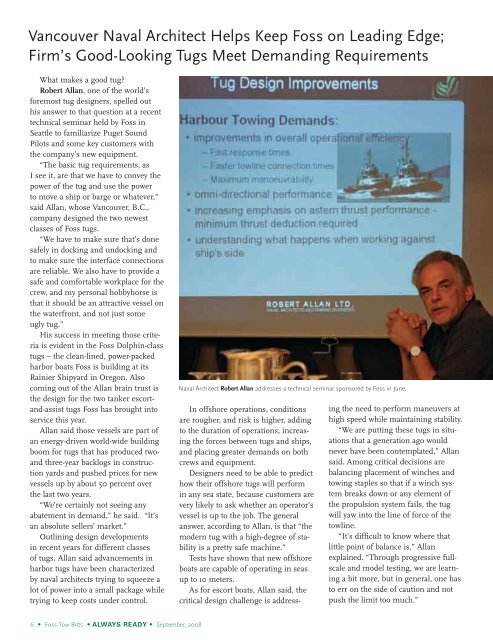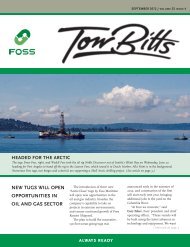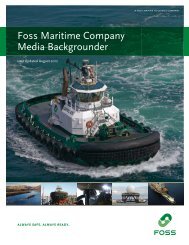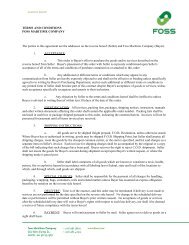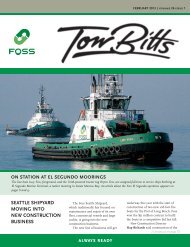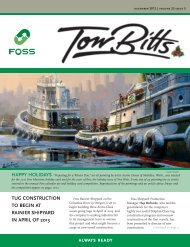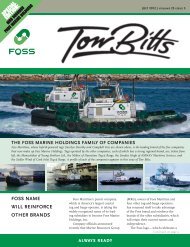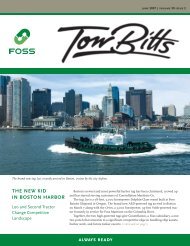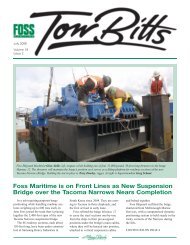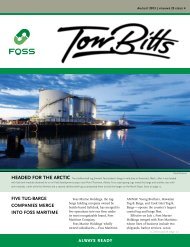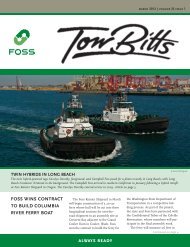Create successful ePaper yourself
Turn your PDF publications into a flip-book with our unique Google optimized e-Paper software.
Vancouver Naval Architect Helps Keep <strong>Foss</strong> on Leading Edge;<br />
Firm’s Good-Looking Tugs Meet Demanding Requirements<br />
What makes a good tug?<br />
Robert Allan, one of the world’s<br />
foremost tug designers, spelled out<br />
his answer to that question at a recent<br />
technical seminar held by <strong>Foss</strong> in<br />
Seattle to familiarize Puget Sound<br />
Pilots and some key customers with<br />
the company’s new equipment.<br />
“The basic tug requirements, as<br />
I see it, are that we have to convey the<br />
power of the tug and use the power<br />
to move a ship or barge or whatever,”<br />
said Allan, whose Vancouver, B.C.,<br />
company designed the two newest<br />
classes of <strong>Foss</strong> tugs.<br />
“We have to make sure that’s done<br />
safely in docking and undocking and<br />
to make sure the interface connections<br />
are reliable. We also have to provide a<br />
safe and comfortable workplace for the<br />
crew, and my personal hobbyhorse is<br />
that it should be an attractive vessel on<br />
the waterfront, and not just some<br />
ugly tug.”<br />
His success in meeting those criteria<br />
is evident in the <strong>Foss</strong> Dolphin-class<br />
tugs – the clean-lined, power-packed<br />
harbor boats <strong>Foss</strong> is building at its<br />
Rainier Shipyard in Oregon. Also<br />
coming out of the Allan brain trust is<br />
the design for the two tanker escortand-assist<br />
tugs <strong>Foss</strong> has brought into<br />
service this year.<br />
Allan said those vessels are part of<br />
an energy-driven world-wide building<br />
boom for tugs that has produced twoand<br />
three-year backlogs in construction<br />
yards and pushed prices for new<br />
vessels up by about 50 percent over<br />
the last two years.<br />
“We’re certainly not seeing any<br />
abatement in demand,” he said. “It’s<br />
an absolute sellers’ market.”<br />
Outlining design developments<br />
in recent years for different classes<br />
of tugs, Allan said advancements in<br />
harbor tugs have been characterized<br />
by naval architects trying to squeeze a<br />
lot of power into a small package while<br />
trying to keep costs under control.<br />
Naval Architect Robert Allan addresses a technical seminar sponsored by <strong>Foss</strong> in June.<br />
In offshore operations, conditions<br />
are rougher, and risk is higher, adding<br />
to the duration of operations, increasing<br />
the forces between tugs and ships,<br />
and placing greater demands on both<br />
crews and equipment.<br />
Designers need to be able to predict<br />
how their offshore tugs will perform<br />
in any sea state, because customers are<br />
very likely to ask whether an operator’s<br />
vessel is up to the job. The general<br />
answer, according to Allan, is that “the<br />
modern tug with a high-degree of stability<br />
is a pretty safe machine.”<br />
Tests have shown that new offshore<br />
boats are capable of operating in seas<br />
up to 10 meters.<br />
As for escort boats, Allan said, the<br />
critical design challenge is addressing<br />
the need to perform maneuvers at<br />
high speed while maintaining stability.<br />
“We are putting these tugs in situations<br />
that a generation ago would<br />
never have been contemplated,” Allan<br />
said. Among critical decisions are<br />
balancing placement of winches and<br />
towing staples so that if a winch system<br />
breaks down or any element of<br />
the propulsion system fails, the tug<br />
will yaw into the line of force of the<br />
towline.<br />
“It’s difficult to know where that<br />
little point of balance is,” Allan<br />
explained. “Through progressive fullscale<br />
and model testing, we are learning<br />
a bit more, but in general, one has<br />
to err on the side of caution and not<br />
push the limit too much.”<br />
6 • <strong>Foss</strong> <strong>Tow</strong> <strong>Bitts</strong> • ALWAYS READY • <strong>September</strong>, <strong>2008</strong>


